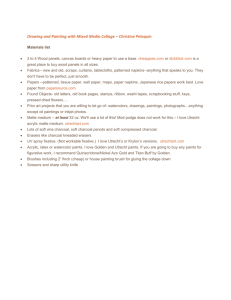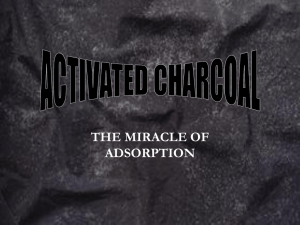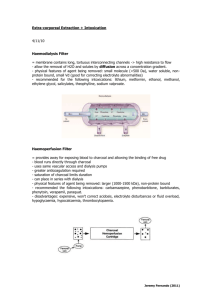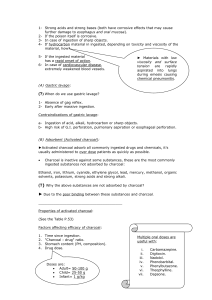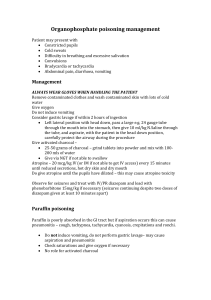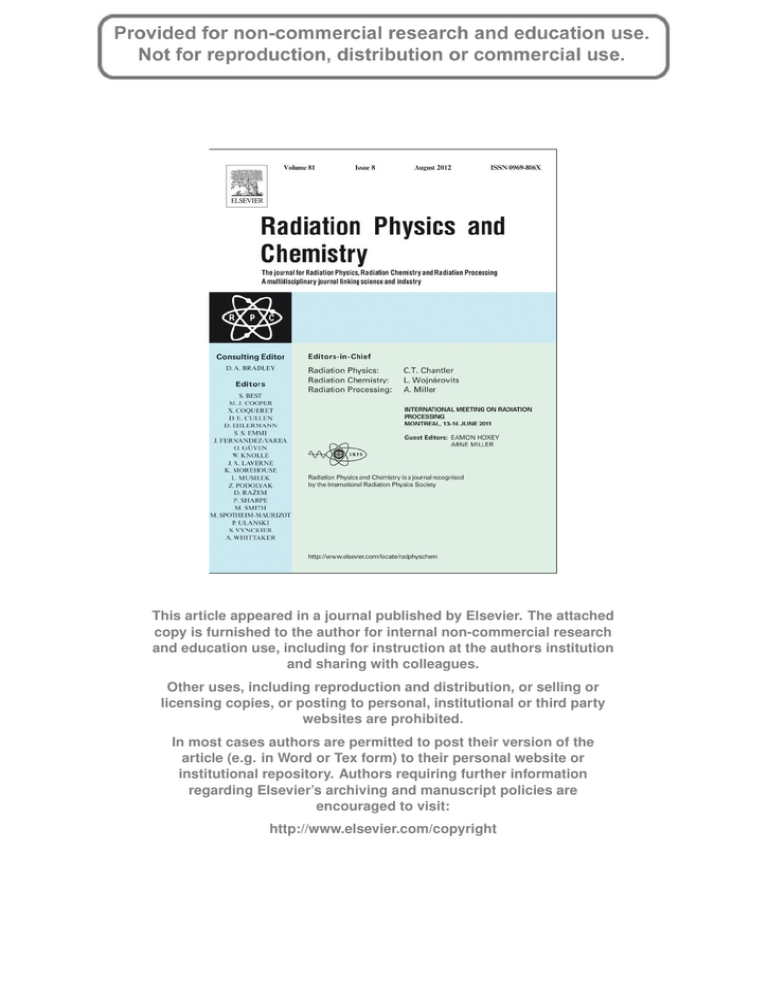
This article appeared in a journal published by Elsevier. The attached
copy is furnished to the author for internal non-commercial research
and education use, including for instruction at the authors institution
and sharing with colleagues.
Other uses, including reproduction and distribution, or selling or
licensing copies, or posting to personal, institutional or third party
websites are prohibited.
In most cases authors are permitted to post their version of the
article (e.g. in Word or Tex form) to their personal website or
institutional repository. Authors requiring further information
regarding Elsevier’s archiving and manuscript policies are
encouraged to visit:
http://www.elsevier.com/copyright
Author's personal copy
Radiation Physics and Chemistry 81 (2012) 1103–1106
Contents lists available at SciVerse ScienceDirect
Radiation Physics and Chemistry
journal homepage: www.elsevier.com/locate/radphyschem
Volatile compounds and odor preferences of ground beef added
with garlic and red wine, and irradiated with charcoal pack
Kyung Haeng Lee a, Hyejeong Yun b, Ju Woon Lee c, Dong Uk Ahn d, Eun Joo Lee e, Cheorun Jo b,n
a
Department of Food Science and Nutrition, Chungju National University, Jeungpyung 368-701, Republic of Korea
Department of Animal Science and Biotechnology, Chungnam National University, Daejeon 305-764, Republic of Korea
c
Radiation Food Science and Biotechnology, Korea Atomic Energy Research Institute, Jeoungeup 580-785, Republic of Korea
d
Department of Animal Science, Iowa State University, Ames, IA 50011-3150, USA
e
Department of Food and Nutrition, University of Wisconsin-Stout, Menomonie, WI 54751, USA
b
a r t i c l e i n f o
abstract
Article history:
Received 18 May 2011
Accepted 30 October 2011
Available online 7 November 2011
Irradiation is the most efficient non-thermal technology for improving hygienic quality and extending the
shelf-life of food products. One of the adverse effects of food irradiation, however, is off-flavor production,
which significantly affects the sensory preferences for certain foods. In this study, garlic (5%, w/w) and red
wine (1:1, w/w) were added to ground beef to increase the radiation sensitivity of pathogens and improve
meat odor/flavor. Samples were irradiated at 0 or 5 kGy in the presence of charcoal pack. SPME-GC–MS
analysis was performed to measure the changes in the volatile compounds and sensory characteristics of the
samples. The amount of total volatile compounds produced from ground beef was greater when the sample
was irradiated. When garlic and red wine were added to the ground beef, the amount of volatile compounds
significantly increased, and the amount of volatile compounds increased even further after irradiation.
However, when the samples were irradiated with charcoal pack, the amount of volatile compounds
decreased significantly. Sensory evaluation indicated that charcoal pack significantly increased the odor
preferences for both irradiated and non-irradiated ground beef added with garlic. These results indicated
that addition of charcoal pack to ground beef could reduce off-odor problems induced by irradiation, and
this effect was consistent even when certain additives such as garlic and red wine were added.
& 2011 Elsevier Ltd. All rights reserved.
Keywords:
Irradiation
Charcoal pack
Odor
Garlic
Red wine
1. Introduction
Irradiation enhances free radical reactions, resulting in color
changes, lipid oxidation, and odor changes, all of which can generate
a negative impact on the consumer response and quality deterioration (Ahn et al., 2000). Jo and Ahn (2000a, 2000b) reported that
sulfur-containing volatile organic compounds formed from sulfurcontaining amino acids are responsible for most of the characteristic
irradiation off-odors in meat. In addition, meat and meat products are
generally susceptible to oxidative deterioration principally due to the
oxidation of polyunsaturated fatty acids present in phospholipids (Du
et al., 2002), which also results in quality problems upon irradiation.
To relieve the off-odors of certain foods, researchers have studied
active charcoal addition (Kim et al., 2008), silica (Chu et al., 2002),
alumina (Einaga and Futamura, 2005), zeolites (Diaz et al., 2004), and
the combination of a-tocopherol and charcoal pack (Sohn et al.,
2009). Further, various phenol compounds (e.g., gallate and sesamol),
which have been proven to have strong free radical scavenging
activities, may help reduce off-odor production (Ismail et al., 2008).
Kim et al. (2008) reported that charcoal packaging significantly
n
Corresponding author.
E-mail address: cheorun@cnu.ac.kr (C. Jo).
0969-806X/$ - see front matter & 2011 Elsevier Ltd. All rights reserved.
doi:10.1016/j.radphyschem.2011.10.026
decreased the off-odor of irradiated pork, as evaluated by gas
chromatograph/mass spectrometry (GC/MS).
Garlic (Allium sativum L.) is known to possess a variety of
biological activities, including antimicrobial (Kim, 2002), anticancer
(Lawson, 2000; Mousa, 2001), antioxidant (Farhath, 1997; Prasad
et al., 1996) activities, and can prevent lipid oxidation (Thabrew
et al., 2000). Red wine has also been evaluated as a potential source
of antioxidant phytochemicals based on its phenolic content and
in vitro antioxidant activity (Alonso et al., 2002). Yun et al. (2010)
reported that natural food ingredients, including garlic, carrot, and
red wine, increased the efficiency of irradiation in eliminating
pathogens inoculated into meat products.
The objective of this study was to evaluate and compare the
effects of adding garlic and red wine to ground beef in combination with charcoal pack during irradiation on the reduction of offodors and enhancement of sensory characteristics.
2. Materials and methods
2.1. Sample preparation and irradiation
Ground beef, ground garlic, red wine (Carlo Rossi California
Red, USA), and tea bag (T&C, Uiwang, Korea) were purchased from
Author's personal copy
1104
K.H. Lee et al. / Radiation Physics and Chemistry 81 (2012) 1103–1106
a local market. Freshly ground garlic and red wine was mixed
with ground beef (25 g) at a concentration of 5% (w/w, final
concentration) and 1 (1 time of meat weight), respectively.
Powdered charcoal (5 g, Shingi Co. Ltd., Mungyeong, Korea) was
put into a tea bag (85 75 mm2) and sealed.
The prepared samples (370.03 g) of ground beef with no
ingredients, ground beef with garlic, and ground beef with red wine
were transferred into glass bottles (diameter height¼4 14 cm2)
for volatile analyses. The bottles were then sealed with a silicon/
PTFE septum and an open top cap. Half of the bottles were added
with charcoal packs at the top of the bottles and the other half
without charcoal packs. Preliminary analysis revealed that transfer
of samples to the glass bottles resulted in a loss of volatile
compounds. The samples were stored at 4 1C.
Half of the prepared samples were irradiated the next day at a
rate of 1 kGy/h to a final dose of 5 kGy using a cobalt-60 gamma
irradiator. Dosimetry and other procedures were performed as
described by Sohn et al. (2009).
Table 1
Odor preference of ground beef added with ingredients and irradiated with
charcoal pack.
Added
ingredient
None
Garlic 5%
Red wine
1b
0 kGy
5 kGy
Without
charcoal
With
charcoal
SEMa Without
charcoal
With
charcoal
SEMa
2.25b
3.00b
5.25
4.75a
5.25a
5.25
0.382 3.25b
0.445 3.50b
0.479 4.00b
6.00a
6.00a
6.50a
0.530
0.540
0.540
Scores were evaluated by 10 untrained panelists (1, extremely dislike; 5, neither
dislike nor like; 9, extremely like).
Values with different letters (a and b) within the same row differ significantly
(Po 0.05).
a
b
2.2. Solid-phase microextration (SPME) gas chromatograph/mass
spectrometry (GC/MS)
SPME fiber (Supelco, Bellefonte, PA, USA) coated with carboxen/
polydimethylsiloxane (CAR/PDMS, 75 mm thickness) was used to
adsorb headspace volatiles. Before extracting volatiles, the fiber was
cleaned at 250 1C for 5 min in the gas chromatography (GC) injection
port and used immediately to prevent possible contamination.
2.3. Odor evaluation
Odor preferences of the samples were evaluated immediately
after irradiation by 10 sensory panelists who had previously
experienced irradiation off-odors in different research projects
but were not trained for any specific purpose. The samples were
prepared the same as in the volatile compound analysis. Sensory
panelists opened the glass bottles and sniffed each of the samples.
Approximately 2–3 min in fresh air between the samples was
provided. The responses of the panelists were expressed on a
9-point numerical scale (1, extremely dislike; 5, neither dislike
nor like; and 9, like extremely).
2.4. Statistical analysis
The experiment was repeated twice with two observations
per trial. Statistical analysis was performed using one-way Analysis
of Variance (ANOVA). When significant differences were detected,
the differences among the mean values were identified by Student–
Newman–Keul’s multiple range test using SAS software with the
confidence level at Po0.05 (SAS, Release 8.01, SAS Institute Inc.,
Cary, NC, USA). Mean values and standard error of the means were
reported.
3. Results and discussion
When non-irradiated raw meats without any additives were
compared, the sensory scores for the samples with charcoal pack in
Standard error of the means (n¼4).
Weight of red wine used for 1 time of meat weight.
Table 2
Major volatile compounds (total area count 104) produced by ground beef irradiated with charcoal pack and stored for 7 days at 4 1C.
Compound
Day 0
Day 7
0 kGy
SEM
Without
charcoal
With
charcoal
42.50
106.60b
–
25.37a
28.77a
–
–
–
31.87
122.70a
–
b
b
3.73
–
–
5 kGy
SEM
Without
charcoal
With
charcoal
2.836
3.393
–
1.832
3.349
2.640
–
–
84.47a
–
141.33a
72.23
55.17
–
–
–
66.00b
–
72.47b
50.07
45.73
–
–
–
0 kGy
SEM
Without
charcoal
With
charcoal
4.327
–
7.093
10.144
6.883
–
–
–
b
–
33.20
–
–
8.13
14.57a
13.07a
13.47a
–
25.70
–
–
14.73
b
b
5 kGy
SEM
Without
charcoal
With
charcoal
1.261
–
17.350
–
–
3.057
0.776
0.755
–
–
17.30a
–
–
16.63a
–
–
–
–
2.37b
–
–
b
–
–
–
–
2.193
–
–
2.100
–
–
Pentane
2-Butenoic acid
Hexane
3-Methylbutanal
2-Methylbutanal
Benzene
3-Methylpentane
3-Hydroxy-2butanone
1-Pentanol
Hexanal
27.902
4.406
Heptanal
Benzaldehyde
1-Octen-3-ol
2-Pentylfuran
Dodecanal
EthanolBenzene
2-Phenylethyl ester
b
222.07
1-Hexanol
26.77a
227.10
–
5.232
82.083
–
34.90
297.33b
–
37.27
384.33a
–
2.403
17.011
–
20.80a
109.53
–
b
–
114.77a
3.207
35.097
18.80b
22.17
196.47
22.866
24.47
168.37
b
2.899
–
24.43
–
–
–
31.23a
70.23a
4.47
80.27
–
1.93
–
15.67b
50.53b
3.158
27.645
–
1.367
–
3.680
3.508
25.97b
–
–
–
b
–
36.53
43.27a
–
2.23
–
7.27a
–
30.07
4.208
–
1.579
–
0.933
–
2.292
7.33
38.97
13.00a
3.87
2.60
–
–
–
–
b
–
–
–
–
2.706
13.943
1.983
1.370
0.942
–
–
21.93
7.40
3.07
–
4.83a
–
–
25.43
8.60
–
–
b
–
–
1.728
4.219
2.168
–
0.641
–
–
Total volatiles
551.13
565.04
747.93
738.71
379.84a
72.70b
289.80
278.44
Values with different letters (a and b) within the same row with the same dose and storage day differ significantly (Po 0.05).
51.57a
Author's personal copy
K.H. Lee et al. / Radiation Physics and Chemistry 81 (2012) 1103–1106
the glass bottle were higher than that without charcoal pack
(Table 1). Charcoal packs had effect on the higher sensory scores
of garlic-added non-irradiated ones, whereas the samples with
added red wine showed no difference with or without charcoal
pack. Upon irradiation at 5 kGy, all the samples packaged with
charcoal pack scored high regardless of the added ingredients. Sohn
et al. (2009) reported that 10 kGy-irradiated ground beef combined
with charcoal pack and added with a-tocopherol scored higher than
the control group regardless of irradiation after storage. The present
study confirms that even if certain ingredients are present in ground
beef, the effect of charcoal pack is similar.
1105
In non-irradiated ground beef, the major volatile compounds
are pentane, 2-butenoic acid, 3-methylbutanal, 2-methylbutanal,
hexanal, benzaldehyde, bezeneethanol, and 2-phenylethyl ester
(Table 2). Overall, the amount of total volatile compounds did not
change with charcoal pack. Irradiation at 5 kGy increased the
amount of volatile compounds produced, whereas charcoal pack
did not result in any significant difference. After 7 days of storage
at 4 1C, the amount of volatile compounds decreased, and adding
charcoal pack further decreased the amount of volatiles in the
non-irradiated sample. Ahn et al. (2000) reported that many
of the volatile compounds formed by irradiation disappeared or
Table 3
Major volatile compounds (area count 104) produced by ground beef added with garlic and irradiated with charcoal pack during storage for 7 days at 4 1C.
Compound
Day 0
Day 7
0 kGy
SEM
Without
charcoal
With
charcoal
59.80a
3.95a
228.55a
22.85a
–
112.40a
b
b
b
b
b
–
b
6.70a
5 kGy
SEM
Without
charcoal
With
charcoal
3.111
0.247
4.561
1.237
–
4.243
0.849
b
5.05a
–
–
b
–
–
4.45a
b
–
–
9.15a
–
–
0 kGy
SEM
Without
charcoal
With
charcoal
0.177
0.177
–
–
0.177
–
–
–
5.95b
37.75b
–
8.45
–
11.55
–
b
40.85a
–
5.45
–
12.25
5 kGy
SEM
Without
charcoal
With
charcoal
–
0.177
0.269
–
7.110
–
0.180
–
14.55a
29.55a
–
b
–
–
–
b
b
–
20.15a
–
–
–
0.672
2.157
–
0.742
–
–
Propanal
Carbon disulfide
Thietane
3-Methylbutanal
2,3-dimethylthiirane
Allyl methyl sulfide
3-hydroxy-2butanone
1-Pentanol
Hexanal
3,30 -Thiobis-1propene
Propyl-cyclopropane
1-Hexanol
Heptanal
Benzaldehyde
2-Butanal
1-Butylcyclohexene
Diallyl disulfide
2-Phenylethyl ester
36.75a
401.35a
96.10a
b
11.65b
12.60b
2.227
38.756
0.224
–
19.00
113.10
–
19.55
66.90
–
4.217
7.816
15.25a
121.90a
16.90
10.30b
70.90b
7.30
0.276
5.561
1.709
17.55a
213.15
14.90
b
186.30
–
0.884
10.075
3.394
–
112.30a
8.70a
130.85a
–
–
44.15a
28.90
–
b
b
3.00b
–
–
b
17.95
–
8.273
0.141
19.487
–
–
4.702
3.310
–
–
b
9.55
–
–
–
20.95a
–
–
3.30a
13.65
–
–
–
11.05b
–
–
0.283
1.471
–
–
–
1.579
98.95a
b
7.15
28.95
7.40a
9.30a
14.50a
–
b
70.90a
6.80
24.15
b
b
b
6.95
1.025
2.475
0.729
2.261
0.071
0.495
1.202
1.662
b
–
30.60
39.55b
–
b
–
9.10
58.30a
–
33.85
60.35a
–
8.50a
–
–
1.626
–
1.325
1.226
–
0.636
–
2.263
Total volatiles
1286.65a
51.90b
167.65
128.05
384.00a
255.85b
368.95
367.45
5.485
Values with different letters (a and b) within the same row with the same dose and storage day differ significantly (Po 0.05).
Table 4
Major volatile compounds (area count 104) produced by ground beef with red winea and irradiated with charcoal pack during storage for 7 days at 4 1C.
Compound
Day 0
Day 7
0 kGy
SEM
Without
charcoal
With
charcoal
Ethyl ester acetic acid
3-Methyl-1-butanol
2-Methyl-1-butanol
Hexanal
Tetrahydrothiophene
Tetrahydro-3-furanol
Butanoic acid
2-Propenal
3-Methyl-1-butanol
Hexanoic acid
2,4-Hexadienoic acid
Benzeneethanol
2-Ethoxythiazole
Pentanoic acid
18.23a
63.37a
28.87a
–
1.13
1.93
–
3.63
5.17a
33.87
9.37
15.23
2.47a
4.37
b
52.67b
22.37b
–
–
3.47
–
4.30
b
26.87
11.83
21.03
0.60b
3.20
Total volatiles
187.64a
146.34b
0.332
1.117
0.429
–
0.801
0.724
–
0.388
0.165
2.273
1.891
3.517
0.435
0.726
5 kGy
SEM
Without
charcoal
With
charcoal
11.77a
54.90a
23.63a
4.17
–
–
–
3.43a
–
31.23
4.47
17.90
–
4.73
0.53b
41.07b
17.87b
6.63
–
–
–
b
–
23.30
3.37
17.13
–
3.47
156.13a
113.37b
2.039
1.775
0.872
0.965
–
–
–
0.094
–
2.645
0.598
2.114
–
0.595
0 kGy
SEM
Without
charcoal
With
charcoal
23.07a
92.10a
43.43a
–
–
–
7.83a
–
–
25.47a
25.93
34.70
5.07
4.07a
1.33b
48.80b
20.67b
–
–
–
–b
–
–
7.37b
16.80
30.43
2.20
b
261.67a
127.60b
0.947
2.714
1.200
–
–
–
0.613
–
–
1.960
3.265
1.303
0.837
0.572
Values with different letters (a and b) within the same row with the same dose and storage day differ significantly (P o 0.05).
a
Weight of red wine used was 1 time of meat weight.
5 kGy
SEM
Without
charcoal
With
charcoal
17.63a
77.13a
35.43a
8.10
–
–
–
–
–
23.23a
3.47
23.23
–
3.37a
b
45.17b
19.60b
11.23
–
–
–
–
–
11.23b
2.83
23.27
–
b
191.59a
113.33b
0.125
2.817
1.132
1.908
–
–
–
–
–
1.160
1.685
0.996
–
0.352
Author's personal copy
1106
K.H. Lee et al. / Radiation Physics and Chemistry 81 (2012) 1103–1106
decreased to very low levels after 5 days of storage under aerobic
conditions, and the amount of total volatile compounds also
decreased from 50% to 25% of the initial level.
A totally different volatile profile was observed when garlic
was added to ground beef (Table 3). Especially, sulfur-containing
compounds such as including carbon sulfide, allyl methyl sulfide,
3,30 -thiobis-propene, and dially disulfide, which did not appear in
the non-irradiated ground beef, were detected. However, adding
charcoal pack reduced the amount of volatile compounds significantly. After irradiation at 5 kGy, the amount of volatile
compounds decreased compared to that of non-irradiated beef
without charcoal pack to a level basically the same as the samples
with charcoal pack. After 7 days of storage, the amount of volatile
compounds decreased significantly in the sample without charcoal pack (Po0.05) and further was reduced by charcoal pack. No
difference was found in the sample irradiated at 5 kGy. When this
analysis was carried out with garlic only (without ground beef
and red wine) 19 different volatile compounds, composed of
mainly sulfur-containing compounds, were identified (data not
shown).
Several alcohols not detected in the non-irradiated ground beef
or non-irradiated ground beef with garlic sample were detected in
the sample with red wine (Table 4). The amount of volatile
compounds decreased with charcoal pack regardless of irradiation
and storage time. Fifteen different volatile compounds, composed
mainly of alcohols and acids, were identified, and charcoal pack
greatly reduced the amount of volatiles when analyzed red wine
only without ground beef and garlic (data not shown).
Ahn et al. (2000) reported that the increase in radiationinduced sulfur-containing volatile compounds in meat was the
result of radiolytic degradation of sulfur-containing amino acids.
However, there was no sulfur-containing compound identified in
the irradiated samples with red wine (Table 4). Previous studies
(Kim et al., 2008; Sohn et al., 2009) also found that the amount of
volatile compounds increased upon irradiation, although not
always in a dose-dependent manner. Jo and Ahn (2000b) reported
that volatile compounds produced and/or increased by irradiation
are associated with lipid oxidation and/or radiolytic degradation
of lipids, amino acids, and proteins. Food ingredients such as
garlic and red wine might have antioxidative effects, which would
help decrease lipid oxidation during storage.
These results indicated that addition of charcoal pack to
ground beef could alleviate the off-odor problems caused by
irradiation, and this observed effect was consistent even when
certain food ingredients such as garlic and red wine were added.
Acknowledgment
This work was supported by a grant from the Next-Generation
BioGreen 21 Program (no. PJ0081330), Rural Development
Administration, Republic of Korea.
References
Ahn, D.U., Jo, C., Olson, D.G., 2000. Analysis of volatile components and the sensory
characteristics of irradiated raw pork. Meat Sci. 54, 209–215.
Alonso, A.M., Guillcn, D.A., Barroso, C.G., Pucrtas, B., Garcia, A., 2002. Determination of antioxidant activity of wines byproducts and its correlation with
polyphenolic content. Food Chem. 50, 5832–5836.
Chu, Y.H., Kim, H.J., Song, K.Y., Shul, Y.G., Jung, K.T., Lee, K., Han, M.H., 2002.
Preparation of mesoporous silica fiber matrix for VOC removal. Catal. Today
74, 249–256.
Du, M., Hur, S.J., Ahn, D.U., 2002. Raw-meat packaging and storage affect the colour
and odor of irradiated broiler breast fillets after cooking. Meat Sci. 61, 49–54.
Diaz, E., Ordonez, S., Vega, A., Coca, J., 2004. Adsorption characterization of
different volatile organic compounds over alumina, zeolites and activated
carbon using inverse gas chromatography. J. Chromatogr. A 1049, 139–146.
Einaga, H., Futamura, S., 2005. Oxidation behavior of cyclohexane on aluminasupported manganese oxides with ozone. Appl. Catal. B: Environ. 60, 49–55.
Farhath, K., 1997. Antioxidative activity of sulfur-containing flavor compounds in
garlic. Biosci. Biotechnol. Biochem. 61, 1482–1485.
Ismail, H.A., Lee, E.J., Ko, K.Y., Ahn, D.U., 2008. Effect of aging time and natural
antioxidants on the color, lipid oxidation and volatiles of irradiated ground
beef. Meat Sci. 80, 582–591.
Jo, C., Ahn, D.U., 2000a. Volatiles and oxidative changes in irradiated pork sausage
with different fatty acid composition and tocopherol content. J. Food Sci. 65,
270–275.
Jo, C., Ahn, D.U., 2000b. Production of volatile compounds from irradiated oil
emulsion containing amino acids or proteins. J. Food Sci. 65, 612–616.
Kim, J.H., Byun, M.W., Sohn, S.H., Jang, A., Lee, K.T., Lee, M., Jo, C., 2008. Reduction
of volatile compounds and an off-odor production in irradiated ground pork
using a charcoal packaging. J. Muscle Foods 19, 194–208.
Kim, J.Y., 2002. Alliinase-independent inhibition of Staphylococcus aureus B33 by
heated garlic. J. Food Sci. 67, 780–785.
Lawson, L.D., 2000. Effect of purified allicin the major ingredient of freshly crushed
garlic on cancer cell proferation. Nutr. Cancer 38, 245–254.
Mousa, A.S., 2001. Discovery of angiogenesis inhibition by garlic ingredients:
potential anti-cancer benefits. FASEB J. 15 (4), A117.
Prasad, K.V.A., Laxdal, M., Yu, B.L., 1996. Evaluation of hydroxyl radical-scavenging
property of garlic. Biochemistry 154, 55–63.
Sohn, S.H., Jang, A., Lim, J.K., Song, H.P., Kim, J.H., Lee, M., Jo, C., 2009. Reduction of
irradiated off-odor and lipid oxidation in ground beef by a-tocopherol
addition and use of a charcoal pack. Radiat. Phys. Chem. 78, 141–146.
Thabrew, M.I., Samarawickrema, N.A., Chandrasena, L.G., Jayasekera, S., 2000.
Protection by garlic against adriamycin induced alterations in the oxidoreductive status of mouse red blood cells. Phytother. Res. 14, 215–217.
Yun, H.J., Kim, H.J., Jung, Y.K., Jung, S., Lee, J.W., Jo, C., 2010. Effect of natural
ingredients and red wine for manufacturing meat products on radiation
sensitivity of pathogens inoculated into ground beef. Korean J. Food Sci. Ani.
Resour. 30, 819–825.



